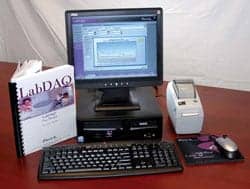Clinical lab industry compliance is complicated. There are multiple organizations and multiple regulations, starting at the institution level, proceeding through industry, state, and federal oversight. Regulations impact procedures, staffing, quality control, safety, and sanitation. Measurements are often specific, and documentation is required. Not hitting these marks can cause infection, which negatively impacts patient care and the bottom line. If a lab has too many violations, it can be shut down.
Therefore, it’s important to stay abreast of regulations. Someone has to know what is required, what has changed, how to meet the requirements, how to document compliance, and how to file so the information is accessible. Sometimes, the responsibilities fall to a compliance officer, whose job is to monitor data; other times, it falls to laboratory management.
Whoever takes the responsibility, compliance requires multiple man-hours to accomplish simple tasks, such as updating regulations, documenting information, analyzing data, and finding the proof when needed, ie, during surprise inspections. One solution: compliance software, which can eliminate the manual labor by automating the simple tasks as well as the more complicated ones.
Compliance Management
Midas+ Accreditation Solutions Group, or ACS Midas+, Corte Madera, Calif, offers two products: Midas+ J Repository to assist with The Joint Commission accreditation standards, and HIPAA Xpediator to manage HIPAA compliance. The Midas+ J Repository comprises seven modules: assessments, tracer methodology, checklists, emergency preparedness, corrective action plans, event and incident reporting, and competency and credentialing. An eighth module, content vault, is optional and permits automatic quarterly updates to an organization’s Joint Commission policies, standards, and forms.
The functions help a laboratory assess how it is doing in meeting the Joint Commission’s requirements, as well as how to improve its compliance so they remain up to date. The system requires 4¼ days for implementation, which includes validation of the software and work group training. Installation is completed by an implementation consultant; within 2 months, an “engagement manager” returns to help set up corrective action plans.
HIPAA Xpediator manages similar tasks for HIPAA regulations. Facilities can use the system to monitor their HIPAA compliance status.
IDENTITY PROTECTION
-
- Shandon CheckMate Verification System
Compliance with regulations means compliance with specimen-labeling requirements. The Joint Commission requires two patient identifiers and is very specific about their use; the College of American Pathologists has regulations, too. But even if not required, keeping patients and samples properly identified is just common sense.
Systems exist to help with labeling and thereby reduce errors, improve patient care, and increase efficiency. ThermoFisher Scientific Anatomical Pathology, Kalamazoo, Mich, offers a line of labeling and verification products designed to keep tissue samples and slides properly associated. “Most of our products are sold to anatomical pathology laboratories where one of the biggest problems is mixing up samples,” says Bill Martin, its product manager for specimen labeling products. He suggests that most mistakes occur at the microtome.
The Shandon CheckMate Verification System (above) scans labels with machine-readable formats (such as bar codes or OCR fonts) that are on the cassettes and slides to ensure they match. It also provides the documentation needed to prove that the specimens matched as they were processed through the lab. Reporting features allow all of this to be viewed quickly. “Labs can calculate workload balance, specimen throughput, and error reporting,” says Martin.
Calculations Management
Software from David G Rhoads & Associates Inc, Kennett Square, Pa, also focuses on methodology but with a different approach, offering a program with statistical modules designed to help a laboratory validate its methods. EP Evaluator Release 7 features 23 statistical modules, the three newest of which include incident tracking, average of normals, and two-instrument comparison.
“The system puts information in a form that is readily understandable and can provide a yes or no answer to questions of compliance,” says David G Rhoads, PhD, DABCC, president of the company. For example, he says a technologist completes a precision experiment, where he typically runs 20 replicates of a specimen. The results are fed into the system, which calculates the mean and standard deviation and determines whether the results are acceptable.
Rhoads suggests that many laboratories now handle these calculations in Excel or on paper. “The program allows users to put the information into the database and then generate reports,” says Rhoads, suggesting that they can be used to improve performance over time. “For instance, if you have an effective quality-improvement program, then ideally, the number of incidents will decrease over time,” he says.
Release 8, due out in the third quarter of 2008, will feature four new modules, for a total of 27. These will include one on inventory management and three related to international normalized ratios. “Inventory affects the quality of the lab,” says Rhoads, describing an incident in one large facility where the ER was shut down as a result of the laboratory running out of essential test kits.
Data Management
Bio-Rad Laboratories’ Serge Jonnaert, business unit manager for quality control informatics products, says, “If your quality control is no good, how good are your patient results?” Good software will not only provide tools to generate reports but also to design better control strategies.
Bio-Rad, headquartered in Hercules, Calif, designed Unity Real Time with this in mind. The quality control data management solution facilitates compliance under CLIA and ISO 15189 as well as other worldwide regulations and accreditations. Functions include Westgard rule evaluation with comprehensive audit trails, streamlined bench-level technologist and supervisory QC data review (a dashboard), advanced charts and reports to troubleshoot test system errors, and automatic submission to the Unity Interlaboratory Program to compare results against the largest peer groups in the industry.
According to Jonnaert, thousands of labs participate in the program so interlaboratory reports can be created for specific instruments and posted online. Deviation from these normals can indicate a problem with an individual laboratory’s test system, before it becomes evident through regular measures.
The Westgard Advisor module automatically recommends and implements best QC rules for each test. “By establishing proper quality control design, the Westgard Advisor module can greatly decrease false rejections and, in the process, save valuable time and consumables—ie, save money—by eliminating unnecessary troubleshooting and repeat testing associated with false rejections,” says Jeff Larson, Bio-Rad’s senior product manager.
The system integrates with others, including LIS, middleware, and instruments to pull data automatically. Training can be handled remotely, and is often completed within 2 to 3 hours; focus is modified for level of use.
BANKING ON BLOOD
Not only must blood banks meet many of the same requirements as clinical laboratories, but they must also manage donor-specific regulations. Diseases, many serious, can be passed through the blood supply, and proper management helps to ensure that they don’t. Naturally, software can help here, too.
Wyndgate Technologies, El Dorado Hills, Calif, offers two programs to assist with management of donated blood. SafeTrace is an information tracking and management system with functions for donor recruitment, donor management, special transfusion/product requirements, ISBT128 labeling, laboratory, inventory distribution, billing, external client testing and contract management, customized reports and donor call lists, and convenient online appointment scheduling for regular donors. The system offers extensive safety checks throughout and supports current and emerging guidelines from institutions such as the AABB, FDA, and HIPAA.
SafeTraceTx is a transfusion management system for large and small operations. Functions include multihospital, multisite capabilities; electronic, remote, and routine cross-matching; an HL7 ADT orders and results interface; ISBT128 on-demand label printing; reagent quality control; reports by patient, product usage by physician/specialty, workload, and wasted products; and detailed bill generation.
Lab Management
Laboratory information systems approach compliance with their own twist, offering assistance in a more indirect form than dedicated compliance software. Rather than managing the process of compliance, the LIS can assist with actual tasks and data storage. It provides a centralized database of laboratory information, such as inventory, laboratory orders, results, and quality control.
SCC Soft Computer, Clearwater, Fla, offers many solutions for the laboratory including a comprehensive LIS suite comprising SoftLab for clinical laboratories, SoftMic for microbiology laboratories, and SoftPath for pathology. SoftLab is designed to integrate multisite laboratories and can help to create consistency in compliance throughout an organization. Gilbert Hakim, SCC’s CEO, cites examples that include rules verification, positive ID, medical necessity, error tracing, and documentation.
“Our software was designed around Lean Six Sigma, so the clustering of instruments and autoverification through a rules engine and artificial intelligence allows the lab to improve productivity,” says Hakim.
LabDAQ LIS from Antek Healthware LLC, Reisterstown, Md, also offers several features to automate quality assurance, including real-time display of Westgard Rules flags, tracking of quality control expiration dates (such as those on reagents), and statistical control analysis on control crossover studies. “QC can be reviewed and corrected actions documented both in real time or postprocessing,” says Antek’s vice president of operations, Jim Kasoff.
Storage of the information in a central database makes reporting easier. Compliance tools include Levey-Jennings reports, control summary reports, and QC exclusions reports. Managers can review how departments are doing with QC audits at any time; data can also be exported to other systems, such as the EMR. Another function of the LIS is to validate medical necessity and reimbursement codes. “An insurance filtering feature automatically reroutes nonreimbursable testing from the laboratory’s in-house test menu to the appropriate reference lab,” says Kasoff.
HIPAA compliance is built in, too. Comprehensive security settings allow administrators to control what users can access. Individuals can be prevented from viewing requisitions, editing and processing results, viewing secure panels (such as HIV), and/or accessing quality control. And the system monitors backups. Antek offers three strategies and will alert users if any of the backups fail to run.
IntelliLab from Impac Medical Systems, Sunnyvale, Calif, will provide regular backup functionality as well as track patient privacy and HIPAA regulations. To provide a strong link between patients and samples, specimens are bar-coded with labels produced by the system. Advanced ordering features ensure maximum reimbursement.
-
- LabDAQ LIS, Antek HealthWare
While proper billing can have a direct impact on the bottom line, the major advantage to an LIS is efficiency, particularly when combined with workflow analysis. “I think when you put in an LIS, you have the ability to ultimately increase profitability through increased capacity with the same levels of staffing,” says Rob MacMillan, Impac’s vice president of product management.
Training does not take long, particularly for the basics. Because there is a difference in using the system and maximizing its use, Impac offers ongoing training. “After users have become familiar with the basics of the software, we can provide information that will help them get its full value,” says MacMillan. One way is customized reports, which can be created to reflect specific needs. “If there is something the system does not generate, we can write reports for them,” says MacMillan.
Middle Management
Customization is a key feature of middleware, whether in reporting or autoverification. Like the LIS, middleware can help with compliance indirectly, particularly with regard to quality control. And like the LIS, the software is intended to increase laboratory and technologist efficiency.
The EasyLink Informatics System from Dade Behring, Deerfield, Ill, features enhanced autoverification, quality control software, intelligent-device management, sample management, browser-based networking capability to connect multiple locations within a hospital network, and user-defined reporting. “The system removes subjectivity from the analysis and review of results so that the same set of rules is applied to every result that is released,” says Leslie Dakarian, marketing manager, informatics, at Dade Behring.
The ability to customize rules and reports means that a system can meet users’ needs. “I think the way to increase the value of the software is to really customize it so it meets specific needs. When you’ve seen one lab, you’ve seen one lab,” quips Mike Flanagan, Dade Behring’s director of informatics.
To meet the needs of diverse labs, Dade Behring offers a data management system, the DBNet Information Management System. “Laboratories want to consolidate their view of the patient. This system takes data from different analyzers and pulls it together,”says Flanagan.
The initial investment can range from hundreds of dollars for low-end solutions to six figures for the high end. Generally, price goes up with functionality, but is often less than updating an old LIS, notes Flanagan.
Instrumental Management
-
- Want to read more? Search for compliance in our online archives.
Efficiency has been driving automation for years, particularly as the labor situation has become bleaker. Instruments help with tasks, but they can also offer compliance aids. Biosite Inc, San Diego, has built them into its MeterPro point-of-care instrumentation. “When we first designed the instrument, and as we’ve moved forward with upgrades, we looked at emerging initiatives to examine their impact on our product,” says Andy Quintenz, worldwide product director, diagnostic systems for Biosite.
User IDs, entered through a keypad or bar- code scan, are one advantage. The laboratory manager can decide whether to require the IDs to run a test. “This can ensure that only trained operators are performing the test. Setting up expiration dates can assure that training is current,” says Quintenz.
Similar controls exist for quality. If a QC run has not been completed within the designated time, the instrument will not run patient tests. If new consumables are introduced, the instrument will not run patient tests until the required controls have been run and produced results in the desired range.
A data management program allows the lab manager or POC coordinator to monitor the units remotely. “At any time, they can look at the system and run a report to make sure that the instrumentation and its use are within regulatory guidelines,” says Quintenz. In addition, reports can be printed to show compliance.
Compliance requirements have continued to increase, emerging from organizations such as the Joint Commission and the College of American Pathologists. “At the same time, we see a diminishing workforce in the lab,” says Quintenz. “So we find more opportunities in the industry to add software safeguards and features.”
From instrumentation to high-level management systems, software will continue to help laboratories maintain their compliance in the future.
Renee DiIulio is a contributing writer for CLP.







